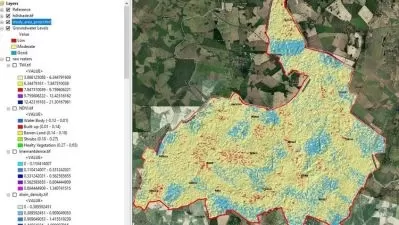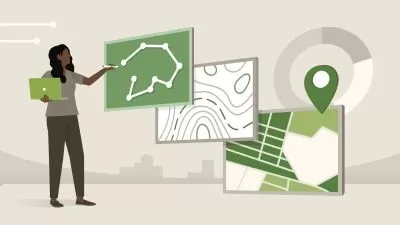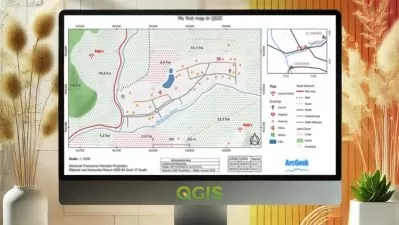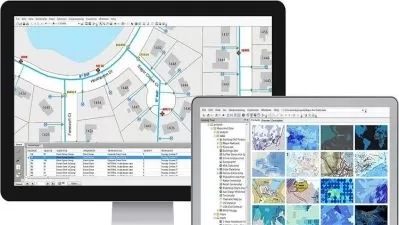A Practical Introduction to 2D River Modelling in HEC-RAS
Nick Wallerstein
8:10:54
Description
A step-by-step guide to building, running and interpreting 2D models using RAS Mapper in HEC-RAS
What You'll Learn?
- Learn to work with RAS Mapper within the HEC-RAS software environment to create terrain layers for 1 and 2D river modelling.
- Learn how to import 1D cross-section data and use it to create a more accurate channel. network.
- Learn how to create Landcover Layers and apply Manning’s n values.
- Learn how to create a 2D mesh, set cell parameters and add Refinement Regions and Breaklines.
- Learn how to build Lateral Structures in order to connect 1D to 2D elements.
- Learn how to adjust a 2D area to create an optimal river channel mesh.
- Learn how to enter unsteady flow Boundary Condition data and Initial Conditions.
- Learn how to set up an Unsteady Run and about Computation Options and Tolerances.
- Learn how to pick an appropriate time-step using the Courant Number.
- Learn how to view 1D and 2D results and understand what the outputs mean.
Who is this for?
What You Need to Know?
More details
DescriptionIn this course you will learn, through 54 short video tutorials, how to construct a combined 1D-2D and a 2D-only river model in the HEC-RAS hydraulic modelling software package. This course, builds on my Udemy 1D HEC-RAS modelling course but is stand-alone and you do not need to take that course in order to follow and complete this one although it would be useful to have a basic understanding of general hydraulic modelling concepts.
All the data necessary to follow and build your models is supplied with this Udemy course and the HEC-RAS software itself is free to download from the web.
Much of the tutorial and model build will focus on the use of the RAS Mapper module within the HEC-RAS software environment. You will learn how to import terrain model data, modify it using surface interpolation techniques and how to create landuse data layers to generate roughness data. You will then go on to learn about 2D geometry creation, how to set cell size and how to adjust cell spacing and alignment to best represent the underlying terrain and likely flow patterns and, in your first model, you will then go on to create a lateral structure to connect 1D to 2D areas. In the second model that you build you will also learn how to represent a main river-channel within a 2D model surface. You will then learn how to enter boundary condition flow data and how to run model scenarios. Several of the tutorials are then focused on discussing both 1D and 2D computation options and tolerances and also how to set the computation interval based upon the Courant Number. You will learn about these various aspects of modelling by making adjustments to your model and then viewing the impact had on the computed results output. Finally, you will learn how to view and manipulate both 1D results in the main HEC-RAS software environment and 2D outputs in RAS mapper along with tips on how to best interrogate and display the output data.
This course will enable you to advance your hydraulic modelling skills from 1D-only simulations to 2D modelling within a geo-referenced terrain environment and as such it will stand you in good stead whether you study river channel processes in academia or work in the river engineering industry.
Who this course is for:
- Those interested in advancing their hydraulic modelling skills from 1D to 2D modelling using RAS Mapper within the HEC-RAS software package.
In this course you will learn, through 54 short video tutorials, how to construct a combined 1D-2D and a 2D-only river model in the HEC-RAS hydraulic modelling software package. This course, builds on my Udemy 1D HEC-RAS modelling course but is stand-alone and you do not need to take that course in order to follow and complete this one although it would be useful to have a basic understanding of general hydraulic modelling concepts.
All the data necessary to follow and build your models is supplied with this Udemy course and the HEC-RAS software itself is free to download from the web.
Much of the tutorial and model build will focus on the use of the RAS Mapper module within the HEC-RAS software environment. You will learn how to import terrain model data, modify it using surface interpolation techniques and how to create landuse data layers to generate roughness data. You will then go on to learn about 2D geometry creation, how to set cell size and how to adjust cell spacing and alignment to best represent the underlying terrain and likely flow patterns and, in your first model, you will then go on to create a lateral structure to connect 1D to 2D areas. In the second model that you build you will also learn how to represent a main river-channel within a 2D model surface. You will then learn how to enter boundary condition flow data and how to run model scenarios. Several of the tutorials are then focused on discussing both 1D and 2D computation options and tolerances and also how to set the computation interval based upon the Courant Number. You will learn about these various aspects of modelling by making adjustments to your model and then viewing the impact had on the computed results output. Finally, you will learn how to view and manipulate both 1D results in the main HEC-RAS software environment and 2D outputs in RAS mapper along with tips on how to best interrogate and display the output data.
This course will enable you to advance your hydraulic modelling skills from 1D-only simulations to 2D modelling within a geo-referenced terrain environment and as such it will stand you in good stead whether you study river channel processes in academia or work in the river engineering industry.
Who this course is for:
- Those interested in advancing their hydraulic modelling skills from 1D to 2D modelling using RAS Mapper within the HEC-RAS software package.
User Reviews
Rating
Nick Wallerstein
Instructor's Courses
Udemy
View courses Udemy- language english
- Training sessions 56
- duration 8:10:54
- Release Date 2022/11/30





























